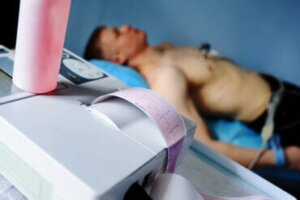Medical Examinations Before Starting a New Sport

Unfortunately, when it comes to medical examinations before taking up a new sport, even doctors are in disagreement. Whilst there are guidelines and recommendations, the truth is, not all specialists come to the same conclusions.
However, there’s enough consensus to say that you should make sure that your heart is in good health. Whilst not common, it’s certainly true that underlying heart conditions have caught out more than one professional athlete in the past.
There are a number of professional athletes who’ve suffered from a cardiac arrest with seemingly no apparent cause. This lack of a clear trigger obviously can cause a great deal of fear and anxiety.
But, the truth is that whilst a cardiac arrest during a sporting event might be front-page news, cardiac arrest is quite common in the general population. Nonetheless, the fear of heart problems in sports is greater and most athletes will undergo some medical examinations before competing professionally.
These checks will include blood pressure tests and checking for arrhythmias, diabetes, and dyslipidemia. Despite this, a check-up before competing won’t always detect any underlying problems, and this is why sometimes, problems are unavoidable.
What are the minimum medical examinations I need?
The following are considered to be the minimum medical examinations that you might need if you’re going to take up a new sport:
- An electrocardiogram.
- A cardiac stress test
- A Doppler echocardiogram.

However, not all athletes will need these. Daily amateur sport is not the same as a professional competition, and the different levels of intensity mean that there are different risk factors.
Ideally, everyone should have an electrocardiogram. This measures the electrical activity of the heart and allows the doctor to detect potential problems, such as arrhythmias.
Then, a cardiac stress test is recommended for athletes over the age of 40, those over 30 with underlying conditions, or those who perform intense exercise. A cardiac stress test measures the heart’s electrical activity whilst the body is in motion and working.
Finally, a Doppler echocardiogram is only really necessary for those who perform high-performance sports. This is an ultrasound of the heart that allows you to see heart activity live through a screen.
Further consultation with your doctor
Any of these tests should ideally be accompanied by a full consultation with your doctor. A physical examination and medical questioning are just as important as the specific tests we’ve mentioned above.
Your doctor will consider the following variables to decide whether you’re fit enough to start or continue practicing your chosen sport:
- Size and weight: the doctor will calculate your Body Mass Index (BMI) and classify you as either normal weight, underweight, overweight, or obese.
- Heart rate: a normal heart rate is generally between 60 and 100 beats per minute. However, for people who train regularly, this can be much lower without an underlying condition. This is because regular exercise makes the heart more efficient.
- Blood pressure: this is a really important measure, especially for older people who practice sport. People with high blood pressure can still exercise, but they need to ensure their blood pressure stays within certain limits. Once they’ve established a routine, physical activity will actually help regulate your blood pressure anyway.
Do I need a revision of my bones and joints?
Whilst there’s absolutely no debate about the importance of checking your heart before taking up a sport, we can’t say the same for your bones and joints. Some professionals argue strongly in favor whilst others consider it unnecessary.

However, specialists commonly accept at least performing a basic check, observing the movement of the spine and the limbs.
If your doctor suspects any problems, they may then request an X-ray, tomography, or MRI scan. This way, you’ll be able to identify any problems without spending too much money or diverting resources from more worthy patients.
Medical examinations are necessary before taking up a sport
In conclusion, if you’re going to take up a new sport, medical examinations are a really important way of detecting any potential health risks. Physical exercise demands a lot from the body, and it’s important to reduce the chances of any complications later on. We recommend getting yourself checked first.
Unfortunately, when it comes to medical examinations before taking up a new sport, even doctors are in disagreement. Whilst there are guidelines and recommendations, the truth is, not all specialists come to the same conclusions.
However, there’s enough consensus to say that you should make sure that your heart is in good health. Whilst not common, it’s certainly true that underlying heart conditions have caught out more than one professional athlete in the past.
There are a number of professional athletes who’ve suffered from a cardiac arrest with seemingly no apparent cause. This lack of a clear trigger obviously can cause a great deal of fear and anxiety.
But, the truth is that whilst a cardiac arrest during a sporting event might be front-page news, cardiac arrest is quite common in the general population. Nonetheless, the fear of heart problems in sports is greater and most athletes will undergo some medical examinations before competing professionally.
These checks will include blood pressure tests and checking for arrhythmias, diabetes, and dyslipidemia. Despite this, a check-up before competing won’t always detect any underlying problems, and this is why sometimes, problems are unavoidable.
What are the minimum medical examinations I need?
The following are considered to be the minimum medical examinations that you might need if you’re going to take up a new sport:
- An electrocardiogram.
- A cardiac stress test
- A Doppler echocardiogram.

However, not all athletes will need these. Daily amateur sport is not the same as a professional competition, and the different levels of intensity mean that there are different risk factors.
Ideally, everyone should have an electrocardiogram. This measures the electrical activity of the heart and allows the doctor to detect potential problems, such as arrhythmias.
Then, a cardiac stress test is recommended for athletes over the age of 40, those over 30 with underlying conditions, or those who perform intense exercise. A cardiac stress test measures the heart’s electrical activity whilst the body is in motion and working.
Finally, a Doppler echocardiogram is only really necessary for those who perform high-performance sports. This is an ultrasound of the heart that allows you to see heart activity live through a screen.
Further consultation with your doctor
Any of these tests should ideally be accompanied by a full consultation with your doctor. A physical examination and medical questioning are just as important as the specific tests we’ve mentioned above.
Your doctor will consider the following variables to decide whether you’re fit enough to start or continue practicing your chosen sport:
- Size and weight: the doctor will calculate your Body Mass Index (BMI) and classify you as either normal weight, underweight, overweight, or obese.
- Heart rate: a normal heart rate is generally between 60 and 100 beats per minute. However, for people who train regularly, this can be much lower without an underlying condition. This is because regular exercise makes the heart more efficient.
- Blood pressure: this is a really important measure, especially for older people who practice sport. People with high blood pressure can still exercise, but they need to ensure their blood pressure stays within certain limits. Once they’ve established a routine, physical activity will actually help regulate your blood pressure anyway.
Do I need a revision of my bones and joints?
Whilst there’s absolutely no debate about the importance of checking your heart before taking up a sport, we can’t say the same for your bones and joints. Some professionals argue strongly in favor whilst others consider it unnecessary.

However, specialists commonly accept at least performing a basic check, observing the movement of the spine and the limbs.
If your doctor suspects any problems, they may then request an X-ray, tomography, or MRI scan. This way, you’ll be able to identify any problems without spending too much money or diverting resources from more worthy patients.
Medical examinations are necessary before taking up a sport
In conclusion, if you’re going to take up a new sport, medical examinations are a really important way of detecting any potential health risks. Physical exercise demands a lot from the body, and it’s important to reduce the chances of any complications later on. We recommend getting yourself checked first.
All cited sources were thoroughly reviewed by our team to ensure their quality, reliability, currency, and validity. The bibliography of this article was considered reliable and of academic or scientific accuracy.
- Martínez, Oscar Felipe Erazo, and Jorge Norvey Alvarez Ríos. Muerte súbita en el deporte, propuesta de intervención temprana. Revista Iberoamericana de Ciencias de la Actividad Física y el Deporte 7.1 (2018): 23-33.
- Titos Gil, Alfredo. Hipertensión arterial y actividad física. Medicine & Science in Sports & Exercise 16 (2017): 269-274.
- Chávez Casanova, Sandra Mariel, Edward Arturo Ramos Ruiz, and Roberto Carlos Salas Castillo. Clínica del Deporte.(2017).
- Pérez, América, Miguel Resnik, and Jorge González Zuelgaray. Muerte súbita en el deporte. Aspectos legales acerca de su prevención. Insuficiencia cardíaca 5.1 (2010): 17-24.
This text is provided for informational purposes only and does not replace consultation with a professional. If in doubt, consult your specialist.








